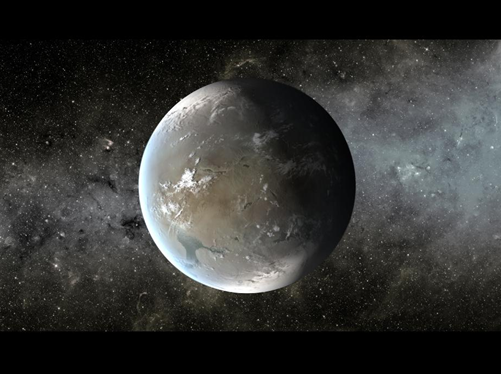On April 18, scientists announce the discovery of three Earth-like planets potentially suited for life. Kepler-62e, Kepler-62f, and Kepler-69c are three unique examples among the total 122 confirmed planets discovered by the Kepler spacecraft. William Borucki, Kepler science principal investigator at NASA's Ames Research Center at Moffett Field, Calif., and lead author of the Kepler-62 system paper in Science, refers to these three planets as the best candidates “by far.”
The first planet to be identified, Kepler-62e, is located 1,200 light years away and within the Lyra constellation. It orbits a K2 dwarf star two-thirds the size of our Sun and one-fifth as bright.
Kepler-62f is also located within a habitable zone of the same star system as Kepler-62e. Habitable zones are the regions around stars where planets have sufficient temperature and atmospheric pressure to maintain the liquid water necessary for life. In our own solar system, Earth and Mars are both located within habitable zones, but Mars cannot currently support life due to its inability to hold an atmosphere.

An artist's rendition of Kepler-62e, courtesy of NASA.
Kepler-62e is 60% larger than Earth and completes a full revolution around its star once every 122.4 Earth days. The planet is believed to be a water world made up mostly of oceans. Its sibling planet, Kepler-62f, is estimated to be 40% larger than Earth. While its exact mass and composition or unknown, scientists speculate the planet's surface to be made of rocky landmasses, bodies of water, and polar caps.

Astronomers estimate Kepler-62f's mass by the association with other similar planets. Image courtesy of NASA.
Kepler-69c is 70% the larger than Earth, but it's the smallest planet yet found that orbits a star similar to our Sun at a habitable distance. The star is a G-type by classification and is 93% the size of the Sun only 80% as luminous. It takes Kepler-69c 242 Earth days to complete its entire revolution around the star. Kepler-69c is believed to be a water-world, boasting oceans thousands of miles deep. Scientists theorize the planet's temperatures to be significantly warmer than Earth's, similar to Venus.
“We only know of one star that hosts a planet with life, the Sun. Finding a planet in the habitable zone around a star like our sun is a significant milestone toward finding truly Earth-like planets,” said Thomas Barclay, Kepler scientist at the Bay Area Environmental Research Institute in Sonoma, CA, and lead author of the Kepler-69 system discovery published in The Astrophysical Journal .
All in all, the atmospheric condition of these planets is unknown; so the concept of them being Earth-like is theoretical and based on associations. Earth-like planets have been identified in the past, but the information we can currently extract is extremely limited. For example, the size of the planet is calculated based on a technique called the transit method, where the change in light from a planet passing in front of a star is measured relative to the light from the star itself.
By Maximilian Teodorescu
Advertisement





